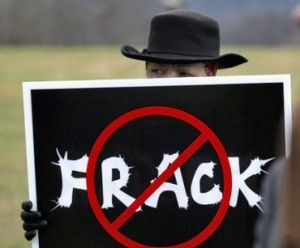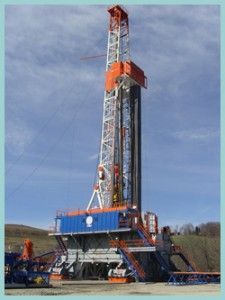CA greens pretend fracking’s past like an ‘X File’ coverup

@chrisreed99: Many #Fracking practices are secret including but not limited to chemicals. Covered-UP extensively starting in 70s. @TXsharon
— Andrea Leon Grossman (@AndreaLeon) October 1, 2013
I wrote a straightforward piece on California and its enormous fracking potential over the weekend that mentioned the Obama administration’s support for the energy-exploration process. That led me to a Twitter run-in with some hardcore green cultists who have elaborate theories about an “X-Files”-esque coverup of the truth about the process — allegedly abetted by the president!
Oh, groan. Fracking has been around for decades. Greens didn’t mind it when it was inefficient. When it became so efficient that it threatened the green-energy bandwagon, then it was declared evil.
But it turns out that it’s just not green Golden State cultists on Twitter who are spreading myths about fracking. It’s mainstream environmental groups. If dishonesty were a crime, this account of fracking by Environment California would have its authors on death row.
Want proof it’s been around a long time and has long been a known quantity? Here’s an excerpt of my Cal Watchdog article on fracking’s history from December.
The truth is fracking has been around since 1947, and according to a University of Texas study, has been used in the drilling of 1 million wells — yes, 1 million. … And not only has it been around for 65 years, five presidents ago, fracking was regularly described as being in “massive” use. This is the first few graphs from an 5,300-word article headlined “Massive frac treatments tapping tight gas sands in Uinta basin” in the Jan. 16, 1978, edition of the Oil & Gas Journal:
“Massive hydraulic fracturing (MHF) is giving favorable results in the low-permeability Wasatch- Mesaverde sands in Utah’s Uinta basin where earlier conventional completions gave marginal gas wells.
“As many as 24 sands over a 3,500-ft gross interval are fractured with up to 1 1/2 million lbs. of sand in one continuous treatment using staged or limited-entry techniques.
“Over 90% of the sands perforated are effectively stimulated. The treatments have given an average sevenfold increase on the nine wells stimulated to date.”
Part of ‘The New Gas Bonanza’ — in 1978
 An 1,800-word Newsweek article from Oct. 30, 1978, headlined “The New Gas Bonanza,” places fracking at the center of one of the big energy stories of the late 1970s:
An 1,800-word Newsweek article from Oct. 30, 1978, headlined “The New Gas Bonanza,” places fracking at the center of one of the big energy stories of the late 1970s:
“Deep beneath southeastern Louisiana lies a 125-mile geological formation called the Tuscaloosa Trend. Several monstrous drilling rigs soar above the surface, probing nearly 4 miles into the earth for deposits of natural gas. The cost of drilling so deep is enormous — about $5 million for each well — and many producers have been discouraged from making the gamble by the low price of any gas they might find. But when he signs the new energy bill Jimmy Carter may give new life to the Tuscaloosa Trend project and scores of other potentially vast gas discoveries. ‘The gas industry,’ says American Gas Association president George Lawrence, ‘is entering an entirely new era.’ ….
“Under the new law, Federal price ceilings on newly discovered gas will be lifted by 1985. In anticipation of higher prices, gas men are already drilling at record levels. And the real bonanza may lie in exotic new sources. As gas prices rise, experts say, both independent drillers and major energy companies seem more likely to commit the huge investments required to tap gas trapped in deep basins or in tight sand, rock and coal formations.”
What was used to tap some of these exotic new sources? You guessed it.
“In many parts of the Northwest, large deposits of shale laid down in the Devonian age contain quantities of gas estimated at 10 trillion to 600 trillion cubic feet. The advantage of the Devonian deposits is that their gas is close to the surface of the earth — and also to gas-starved markets. Their big disadvantage is the tight grip the dense shale holds on its gas, frustrating attempts to make it flow fast enough for economical production.
“Experiments are under way to enhance the flow through advanced hydraulic fracturing. Coarse sand, bauxite pellets or glass beads are mixed with fluid pumped into the shale under high pressure to crack the rock and wedge the cracks open to allow the gas to escape.”
A ‘moderate’ risk that turned out not to be
 As these articles make obvious, fracking was utterly routine decades ago. And were environmentalists terrified by the practice? No, not at all. A study by the U.S. Energy Department cited in a July 21, 1979, National Journal article found that environmental concerns associated with “massive hydraulic fracturing — using water and various chemical compounds at high pressure — [were] ‘moderate’ … They include the degradation of air quality during site preparation and fracturing activities and the risk of surface water contamination.”
As these articles make obvious, fracking was utterly routine decades ago. And were environmentalists terrified by the practice? No, not at all. A study by the U.S. Energy Department cited in a July 21, 1979, National Journal article found that environmental concerns associated with “massive hydraulic fracturing — using water and various chemical compounds at high pressure — [were] ‘moderate’ … They include the degradation of air quality during site preparation and fracturing activities and the risk of surface water contamination.”
These “moderate” concerns never turned into a major issue. Fracking has been common for more than 30 years. So why all of sudden is it now depicted as an evil assault on Mother Earth by environmentalists? Because in the past decade, dramatic gains in its efficiency and effectiveness have made it a game changer, allowing drilling to access immense oil and natural gas reserves in North America that heretofore were considered either unreachable or prohibitively expensive to reach. …
My full Cal Watchdog article is here. Here’s a related editorial.
The point is plain and obvious: The fracking scare has been ginned up in California for political reasons. Back to you, @AndreaLeon.
Related Articles
Puerto Rico experiments with tax cuts
California is experimenting with high taxes. Seventeen months after voters passed Proposition 30, which raised taxes $7 billion a year,
Uh oh
John Seiler: As I keep reminding people, California isn’t the world’s “eighth largest economy,” as our politicians like to flatter
God-like legislators fail to pass enviro reforms
Aug. 24, 2012 By Katy Grimes Despite promises to pass desperately needed reforms to the California Environmental Quality Act, lawmakers



